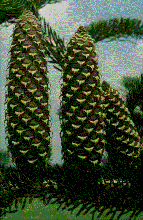 Trees in the Teberda Nature Reserve, Caucasus; Picea orientalis on hillslope in distance [Vladimir Dinets].  Cones (2).
|
Abies nordmanniana (Steven) Spach 1841
Common NamesCaucasian fir; Pikhta kavkazkaya (5).Taxonomic notesSyn: Pinus nordmanniana Steven 1838; Picea nordmanniana (Steven) Loudon 1842; Pinus abies var. nordmanniana (Steven) Muell. 1871; Abies leioclada (Steven) Gord.; A. pectinata var. leioclada (Steven ex Endl.) Carr. 1855. One subspecies, equi-trojani (Aschers. et Sint. ex Boiss.) Coode et Cullen (syn: A. pectinata Lam. et DC. var. equi-trojani Aschers. et Sint. ex Boiss.; A. bornmuelleriana Mattf. and A. cephalonica var. graeca (Fraas) Liu) (5).Vidakovic observes that: "[a]ccording to Flous (6), A. bornmüelleriana is a hybrid between Greek and Caucasian fir, while Mattfeld (7) believes it is a transitional type between the silver fir and Greek fir" (4). Vidakovic suggests that "throughout the entire Caucasus and north Turkey only one species occurs--A. nordmanniana" (4). Farjon provides some further insights to the taxonomic disputes about this group of firs, noting that subspecies, equi-trojani "has been treated as a species by Mattfeld (1925). Earlier proposals to relate it to A. cephalonica or even A. alba have been abandoned by Davis et al. (1965) and Nitzelius (1969), but were again made by Liu (1971)" (5). He also concludes that "[t]he geographically separated populations in W and N Turkey, described under the above mentioned names and at various taxonomic levels, are found to be entirely clinal (Nitzelius, 1969)" (5). DescriptionSee (5).RangeThe typical subspecies occurs in W Caucasia (Abkhazia and Georgia) and in the mountains of NE Turkey and N Turkey (Paphlagonia). Introgression with ssp. equi-trojani forms in the western part of its range. It grows in mountains around the E Black Sea at 900-2100 m, on silicic soils. The climate is continental and wet, with annual precipitation of 1000-3000 mm. It occurs in pure stands or mixed with Picea orientalis, Pinus sylvestris, Fagus orientalis, Acer trautvetteri, Carpinus caucasica, Ulmus elliptica, Acer pseudoplatanus, Tilia caucasica, Taxus baccata and Rhododendron ponticum (5).Ssp. equi-trojani grows in pure stands as isolated relict populations on N slopes of high mountains in W Turkey and on Ulu-Dagh in Bithynia. It prefers calcareous soils (5). Big TreeMzymta River, Caucasus National Reserve, Russia (78 m tall, 360 cm dbh) (3). If accurately measured, this is the largest Abies known. However, it may be that the 360 cm figure represents girth rather than diameter. Outside of its native range, a specimen at Cragside, Northumberland (U.K.) is 47 m tall with a 107 cm dbh, and another at Endsleigh, Devon (U.K.) is 32 m tall with a 165 cm dbh (8).OldestDendrochronologyEthnobotanyObservationsRemarksCitations(1) Silba 1986.(2) van Gelderen et al. 1986. (3) Vladimir Dinets, e-mail communication, 2-Jan-1998. (4) Vidakovic 1991. (5) Farjon 1990. (6) Flous, F. 1936: Classification et evolution d'un groupe d'Abietinées. Travaux Labor. Ford. Toulouse, Tome I, Vol. II, Article XVIII. (7) Mattfeld, J. 1930: Über hybridogene Sippen der Tannen. Bibliotheca Botanica 100:1-84, Stuttgart. (8) Mitchell et al. 1990. See also: |
|
[Abies] [Pinaceae] [home] This page is from the Gymnosperm Database
|